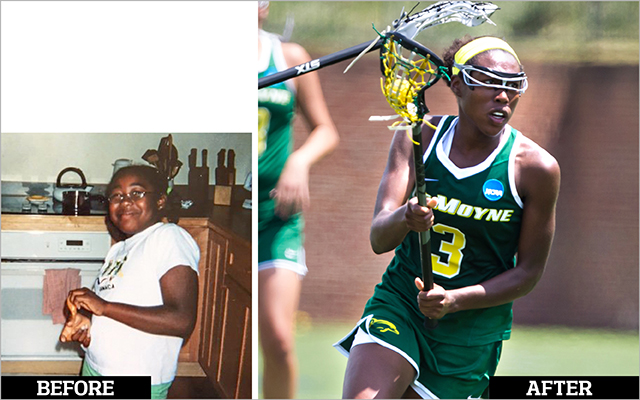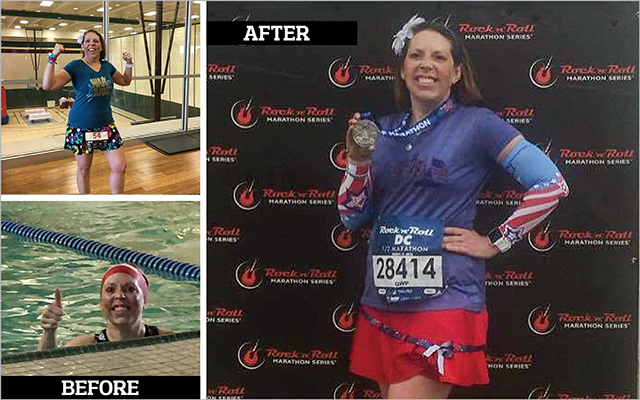These days, healthy habits are woven into the fabric of my life. I love running, and I enjoy cooking nutritious meals with my wife, Mary, and our two daughters. We have a thriving garden and a flock of chickens at our home near Charlottesville, Va. My job at the City Schoolyard Garden allows me to spend every day helping children in my community engage with nature and cultivate skills for healthy living.
But this wasn’t always the case for me. In 2003 I weighed more than 400 pounds and lived in a state of misery. My joints and back perpetually ached, and I was always short of breath. Every morning when I woke up, I wondered if that day would be my last.
At the time, my job in software development kept me living out of a suitcase in Manhattan during the week, eating mostly room service. After dinner, I’d raid the hotel snack bar in an effort to quell my never-ending hunger and sense of shame.
On weekends I’d return home, where my family was also struggling. Mary was overweight, as was 13-year-old Stephanie. Unless something changed, we knew Raven — then just 8 years old — would follow in our unhealthy footsteps.
Leaving a Legacy
My parents, like Mary’s, grew up in small farming communities. Though they lived in the city during my childhood, they retained some of their agrarian habits. They kept a garden, and my father bought live chickens he killed, plucked, and served at meals. Cooking as a family was a fundamental part of the traditions that bound us, and we ate mostly homemade meals of whole foods.
But my parents still ate more processed foods than their parents had — and began gaining weight at a younger age. My struggle began even earlier, and now I was watching it happen to my own children.
Over the years, Mary and I tried dozens of diets. We’d lose a bit of weight, then gain it all back once the diet ended — plus a few extra pounds. I tried to follow the prevailing health advice: I eschewed whole milk and eggs, swapped butter for margarine, replaced animal fat with vegetable oil.
I didn’t realize that I struggled to lose weight because my diet didn’t fulfill my nutritional needs. The typical medical recommendation to “eat less and exercise more” was useless. How do you eat less when you’re never satisfied? How do you move more when you can barely walk a city block?
Back to Basics
My cascade of health problems — sleep apnea, hypertension, and prediabetes, to name a few — reached a fever pitch by May 2003. I knew that to change my family’s story, I had to start with my diet.
As an experiment, I tried a 24-hour fast, but I couldn’t hold out all day. That night, I sought out a light dinner at a deli in Manhattan: roasted chicken with vegetables, and water instead of soda.
I woke up the next morning feeling clear-headed, without my typical sugar hangover from the snack bar. My walk to work was less painful than usual. I had a bit more energy and a budding sense of optimism.
At home, my family had a similar revelation after watching a documentary about diabetes. As the credits rolled, my daughters turned to Mary and told her they didn’t want to get sick. By the time I returned home that weekend, they’d cleaned out the kitchen. No more potato chips or frozen chicken tenders. We were going back, Mary told me, to the food we’d eaten when we were young.
We started buying simple, whole foods at the grocery store: meat, veggies, and fruits. We decided we could eat whatever we wanted if we made it ourselves. Sometimes that meant pizza night — but because a homemade pie is more satisfying than a store-bought frozen one, we all ate a little less.
It wasn’t long before Stephanie began losing weight; Raven, who’d been suffering terrible mood swings, was more even-tempered.
I began tracking my meals, which helped me understand portion sizes. I discovered that by tuning in to my body’s feedback, I could eat what I wanted and stop when I felt full.
My old diet had been weighing me down in ways I hadn’t realized. Sure, there were moments when junk food beckoned. But once I switched to whole foods, eating a bag of potato chips would leave me feeling greasy, ill, and still hungry. That awareness — combined with the subtle ways my life had already improved — made it easier to stay the course.
When my New York assignment ended in late June and I was home more often, Mary and I began taking daily walks. At first, I couldn’t go far. But my new diet gave me more stamina, and movement gradually became easier. Even better, those early mornings were a time for us to envision a new, healthful future together.
In September we turned our spare bedroom into a home gym with a treadmill, weightlifting bench, and barbells. Eventually, we added a stationary bike and a whiteboard for writing our daily routines or encouraging notes. We weren’t just “on a diet” — we were changing our lives.
The Farming Life
Over the course of several years, thanks to my new diet, fitness regimen, and family’s support, I lost more than 150 pounds. I found that as I changed my habits, I also changed my mindset.
The lens through which I viewed the world shifted, and I moved from a place of despair to one of optimism. In 2008 I realized my job was no longer a good fit: I wanted to do something that better reflected my values.
I’d started buying food directly from local farmers, and one day, after coming home with a raw, fresh ham from a nearby farm, I Googled the best way to cook it. The quick search took me to the website for Polyface Farm — a local-market farm in the Shenandoah Valley — where I saw a posting for a delivery driver. I applied.
I commuted from our home near Woodbridge, Va., to my new job at the farm. The owners are committed to environmentally friendly agriculture that mimics a natural ecosystem. Having access to their decades of knowledge deepened my respect for our sources of food.
Within a year, my family moved from the suburbs to a new home near Charlottesville with a small plot where we could garden and tend our own flock of chickens. It was a natural progression for our family, to sync our daily lives with our new philosophies and revive our connection with our agrarian roots.
My 10 years at Polyface were an opportunity for me to pass on the lessons I learned from my struggle to live a healthier life. And last May, I began working for the City Schoolyard Garden in Charlottesville, which offers gardening education for children and provides fresh produce for the city’s working poor.
For me, half the benefit of learning to live a healthy life has been helping others do the same.
This originally appeared as “Back to the Land” in the September 2018 print issue of Experience Life.
Richard’s Top 3 Success Strategies
- Clean up your diet. “Stop eating processed food and start doing your own cooking,” Richard advises. “Do this as though your life depends on it — because, really, it does.”
- Make exercise meaningful. Richard and Mary enjoy gardening and doing yardwork together, which makes them feel more connected to their surroundings and to each other.
- Get support. Developing healthy habits was important, but having his family on the same page made a huge difference for Richard. “My wife, Mary, was a real partner in my effort to change my behavior and reclaim my health,” he says.




This Post Has 0 Comments